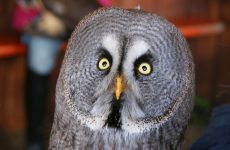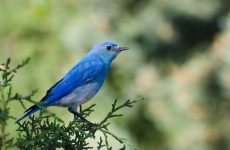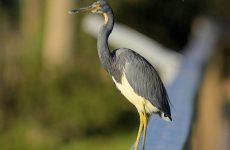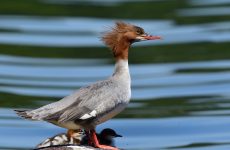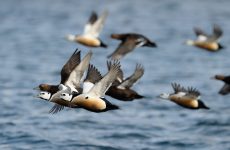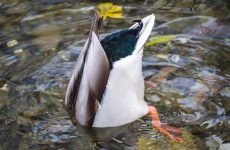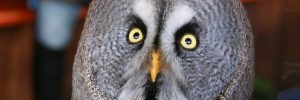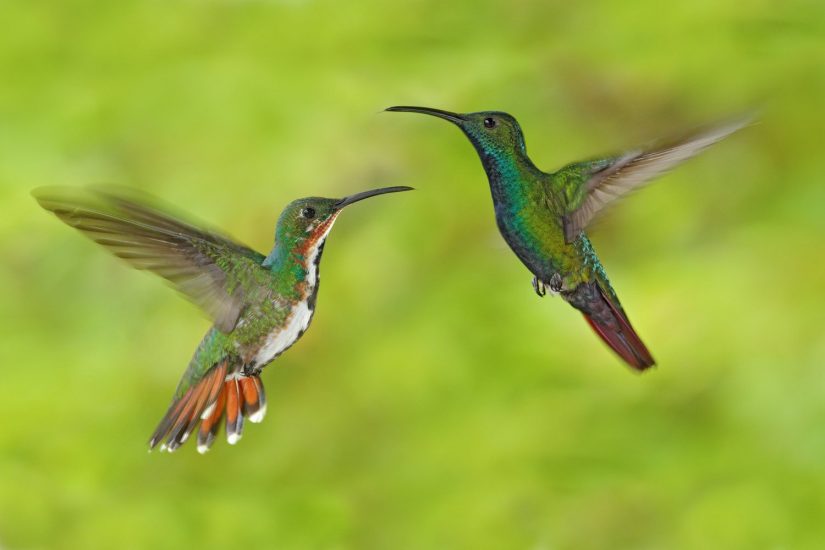
Tiny bursts of color and speed coupled with magnificent hovering skills make the hummingbird one of my favorite bird species with good reason.
Hummingbirds can travel over 4000 miles in a year, fly at 98 km/h, have a wingbeat of an average of 58 beats per second and lay an egg the size of a jelly bean!
There are 360 species of Hummingbird in the world and of these 140 species of Hummingbird are found in North America, if you take the broad view and include all those in Canada, the United States, Mexico, Central America, and the Caribbean.
Hummingbird Species in each Region:
| Regions | Total Species | Unique (Endemic) Species | Common Species |
| USA and Canada | 20 | 0 | 20 |
| Mexico | 58 | 12 | 46 |
| Central America | 110 | 0 | 110 |
| Caribbean | 21 | 15 | 6 |
| South America | 266 | 225 | 41 |
In this article, I will cover the 20 types of hummingbird in North America, including the United States and Canada.
Many Hummingbirds are migratory and spend the winter in Mexico or further south and the summer in the United States and Canada for breeding.
The greatest number of hummingbirds can be seen in southern US states as not only do you get the migrating birds stopping to breed or passing through to more northerly states, you also get some extra species that mainly live south of the border but may occasionally pop over to visit.
Best places to see Hummingbirds in North America:
- At backyard feeders – bring your local hummingbirds to your backyard
- Hummingbird festivals take place at many locations especially in southern states and two of the best are at the Rockport-Fulton HummerBird Celebration in Texas in September and the Sedona Hummingbird Festival in Arizona in late August.
- Hummingbird Havens such as
- Southeastern Arizona Bird Observatory, Bisbee, Arizona
- Davis Mountain State Park, Fort Davis, Texas has 15 species of hummingbirds.
- Rio Grande Valley, Texas, United States
- Cabrillo National Monument, California
20 Species of Hummingbirds in North America:
- Anna’s Hummingbird
- Ruby-throated Hummingbird
- Black-chinned Hummingbird
- Rufous Hummingbird
- Broad-tailed Hummingbird
- Allen’s Hummingbird
- Costa’s Hummingbird
- Broad-billed Hummingbird
- Buff-bellied Hummingbird
- Calliope Hummingbird
- Rivoli’s Hummingbird
- Violet-crowned Hummingbird
- Lucifer Hummingbird
- Blue-throated Mountain-gem
- Mexican Violetear
- White-eared Hummingbird
- Green-breasted Mango
- Berylline Hummingbird
- Plain-capped Starthroat
- Cinnamon Hummingbird
20 Species of Hummingbird North America
1. Anna’s Hummingbird
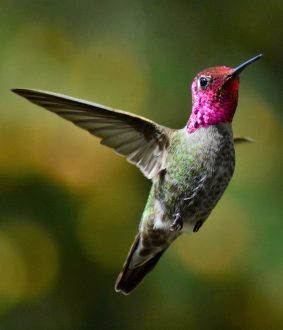
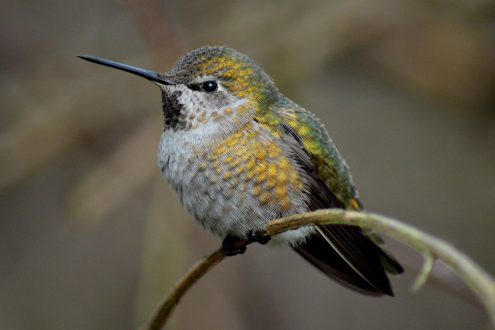
Anna’s Hummingbirds are tiny birds that are mostly green and gray. The male’s head and throat are iridescent reddish-pink the female’s throat is grayish with bits of red spotting.
- Length: 3.9 in (10 cm)
- Weight: 0.1-0.2 oz (3-6 g)
- Wingspan: 4.7 in (12 cm)
Anna’s Hummingbirds do not migrate, which is unusual for hummingbirds. Anna’s Hummingbirds range is from British Columbia to Baja California in both summer and winter. However, some birds may move from the far north of their range for winter.
Anna’s Hummingbirds are the most common hummingbird along the Pacific Coast.
Habitats of Anna’s hummingbirds are often backyards and parks with large colorful blooms and nectar feeders but they are also found in scrub and savannah.
The diet of Anna’s Hummingbirds includes nectar, tree sap, and small insects and spiders. Nectar sources are Eucalyptus, Nicotiana, Agave, Castilleja, Diplaucus, Ribes, Silena, Arctostaphylos as well as nectar feeders.
Anna’s Hummingbirds’ nests are high in trees around 6 – 20 ft and they often have 2-3 broods a year. They make dramatic dive displays during courtship as the males climb up to 130 feet into the air before diving back to the ground with a burst of noise from their tail feathers.
2. Ruby-throated Hummingbird
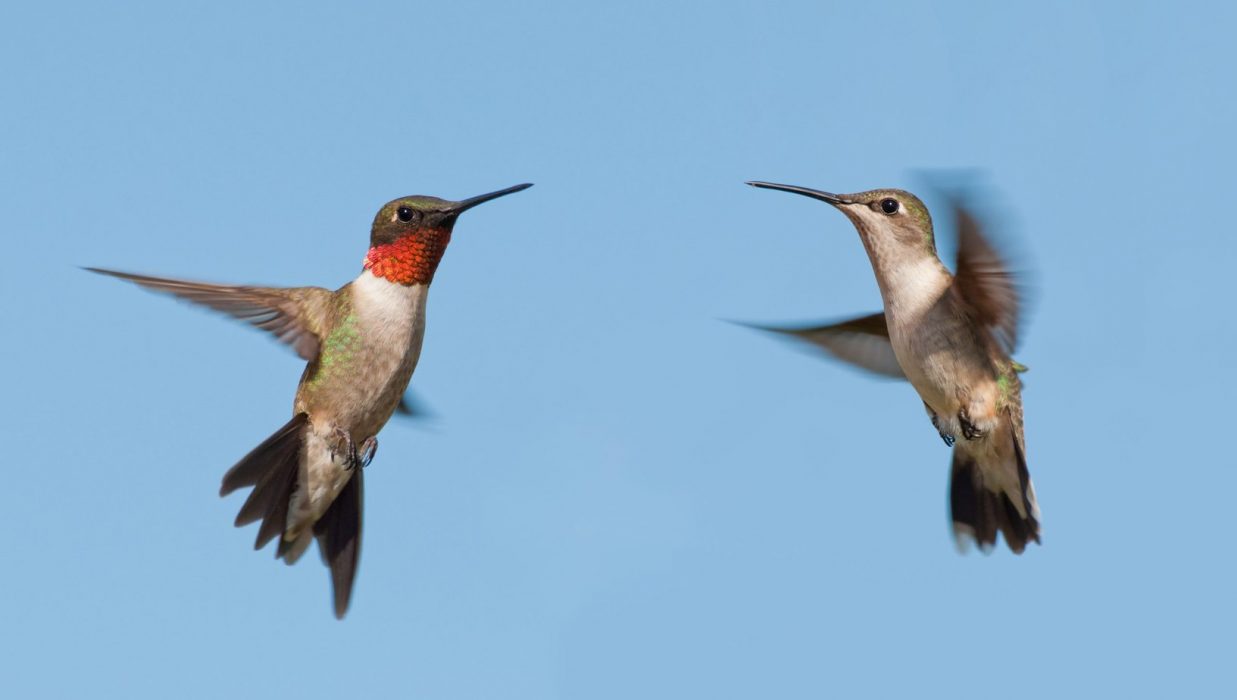
The Ruby-throated Hummingbirds are bright green on the back and crown, with a gray-white underside and the males have an iridescent red throat. Female Ruby-throated Hummingbirds are green on the back and white underneath with brownish crowns and sides.
- Length: 2.8-3.5 in (7-9 cm)
- Weight: 0.1-0.2 oz (2-6 g)
- Wingspan: 3.1-4.3 in (8-11 cm)
The Ruby-throated Hummingbird is the only breeding hummingbird in eastern North America, they then migrate further south to Central America for winter. Some migrate over the Gulf of Mexico or some migrate through Texas around the coast.
Ruby-throated hummingbirds start arriving in the United States in February and may not arrive in northern states and Canada until May for breeding. In Spring males usually arrive first up to one or two weeks before the females.
In the fall Ruby-throated Hummingbirds migrate south in August and September and gather in September along the Gulf Coast of Texas before making the final push south for winter.
These tiny birds zip from one nectar source to the next or catch insects in midair or from spider webs. They occasionally stop on a small twig but their legs are so short they cannot walk, only shuffle along a perch.
Flowering gardens or woodland edges in summer are the best places to find them when out. They are also common in towns, especially at nectar feeders.
Male Ruby-throated Hummingbirds can be aggressive in their defense of flowers and feeders. They do not stick around long after mating and may migrate by early August.
Ruby-throated females build nests on thin branches and make them out of thistle or dandelion down held together with spider silk. They lay 1-3 tiny eggs measuring only 0.6 in (1.3 cm)
3. Black-chinned Hummingbird
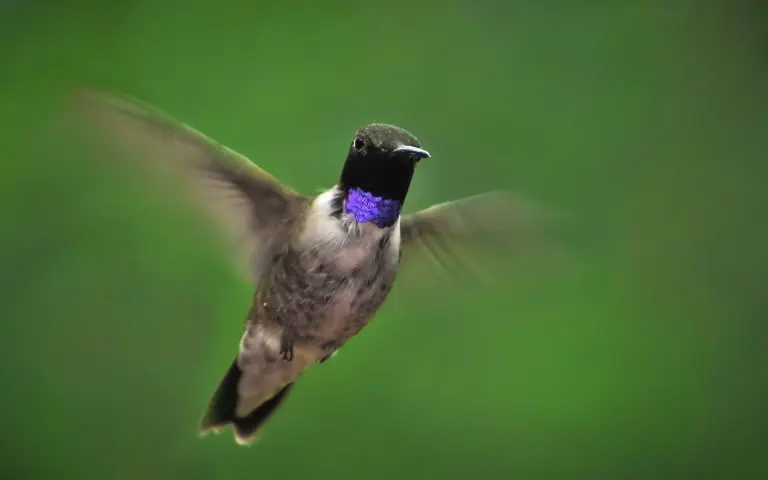
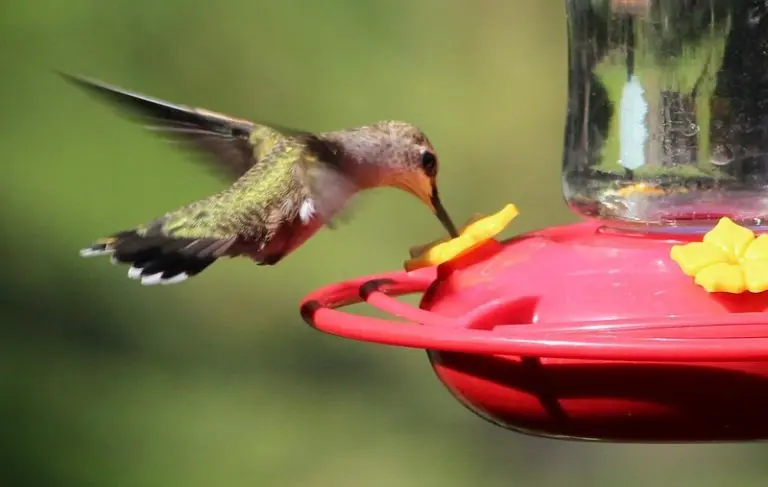
Black-chinned Hummingbirds are dull metallic green on the back and grayish-white underneath. The males have a black throat with a thin iridescent purple base and the females have a pale throat and white tips on the tail feathers.
- Length: 3.5 in (9 cm)
- Weight: 0.1-0.2 oz (2.3-4.9 g)
- Wingspan: 4.3 in (11 cm)
Black-chinned Hummingbirds breed predominantly inland in western states from British Columbia to Baja California in summer. After breeding, they may move to higher mountain areas with abundant flowers before migrating to western Mexico, southern California, and the Gulf Coast in the winter. Migration of Black-chinned Hummingbirds usually occurs in March and September
They eat nectar, small insects, and spiders and their tongues can lick 13-17 times per second when feeding on nectar. Nests of Black-chinned Hummingbirds are made of plant down and spider silk to hold it together and they lay 2 white tiny eggs that are only 0.6 in (1.3 cm)
Black-chinned Hummingbirds can often be seen sitting at the top of dead trees on tiny bare branches and often return to a favorite perch. They can be found along canyons and rivers or by shady oaks.
4. Rufous Hummingbird
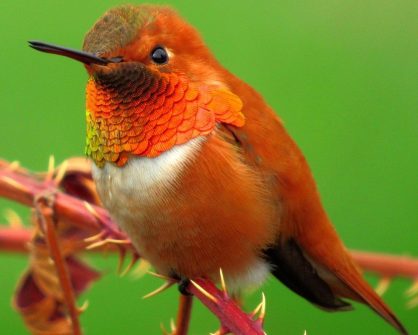
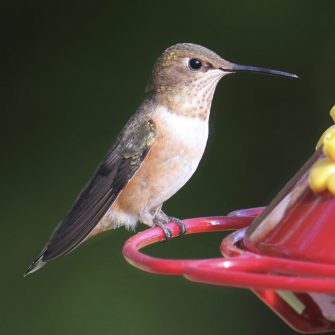
Rufous Hummingbirds are bright orange on the back and belly, a white patch below the throat, and an iridescent red throat in the males. The females are greenish-brown on the back and rusty colored on the sides with a whitish belly. Their numbers are in decline by around 60% since the 1970s
- Length: 2.8-3.5 in (7-9 cm)
- Weight: 0.1-0.2 oz (2-5 g)
- Wingspan: 4.3 in (11 cm)
Rufous Hummingbirds are one of the longest migrating birds relative to their size, traveling up to 4000 miles each way. They breed in northwest Alaska and northwest Canada in the summer and migrate down to Mexico and the Gulf Coast for winter.
Migration of Rufous Hummingbirds is north along the Pacific Coast in spring and by the Rocky Mountains in late summer and fall. Migration in the spring of Rufous Hummingbirds starts in February and they usually reach Alaska by mid-April. Migration in the fall is in July and August and ends by October.
A study has shown that Rufous Hummingbirds are starting their migration earlier and traveling north more inland than before.
Rufous Hummingbirds feed mostly on nectar from colorful tubular flowers and from insects such as gnats, midges, and flies. They build a nest high up in trees using soft plant down and spider webs to hold it together. They lay 2-3 tiny white eggs that are about 0.5 in (1.3 cm) long. Their habitat is mountain meadows and coniferous forests.
They are very aggressive and chase off any other hummingbirds that may appear, even larger hummingbirds or resident ones during migration. During migration, they won’t hang around long but will still chase off most other hummingbirds given a chance.
Check out these great articles:
- Live Hummingbird Nest and Feeder Cams
- Common Backyard Birds North America for every state – with Free picture ID printable
- 25 Birds with Red Heads in North America
- 20 Live Feeder Cams from Around the World
5. Broad-tailed Hummingbird
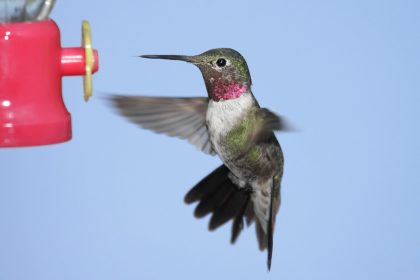
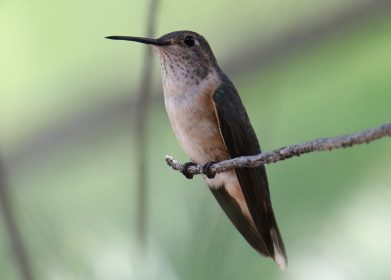
Broad-tailed Hummingbirds live in higher elevations and are iridescent green on the back, brownish in the wings, and white on the chest and into the belly. Males have an iridescent rose throat, females and juveniles have green spots on their throats and cheeks.
- Length: 3.1-3.5 in (8-9 cm)
- Weight: 0.1-0.2 oz (2.8-4.5 g)
Broad-tailed Hummingbirds breed in high meadows and open woodlands between 5,000 – 10,000 feet elevation in the mountainous west, between late May and August between central Idaho, southern Montana, northern Wyoming, and south to California
Migration south is to southern Mexico for winter but some Broad-tailed Hummingbirds may stay on the Gulf Coast. Migration of Broad-tailed Hummingbirds occurs in April and late August and September
Due to the cold at higher elevations, the Broad-tailed Hummingbird can slow their heart rate and drop their body temperature to enter a state of torpor.
Nectar from flowers is the usual food of hummingbirds and Broad-tailed Hummingbirds drink from larkspur, red columbine, sage, scarlet gilia and they will also come to hummingbird nectar feeders. They supplement their diet with small insects and will feed their young on insects too.
Broad-tailed Hummingbird nests are usually on evergreen or aspen branches and are made with spider webs and gossamer under overhanging branches for added insulation during cold nights.
6. Allen’s Hummingbird
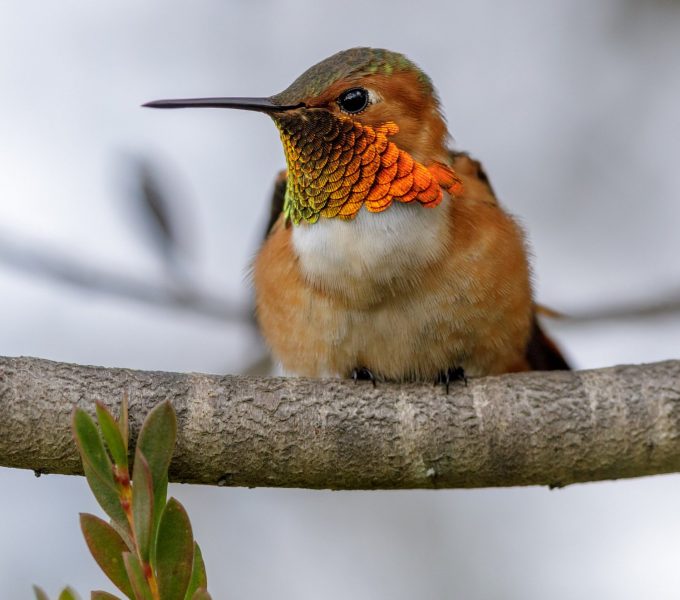
Allen’s Hummingbirds look very similar to Rufous Hummingbirds so it’s hard to tell them apart in the narrow band of coastal forest and scrub they inhabit between California and Oregon.
Male Allen’s Hummingbirds have iridescent reddish-orange throats and orange bellies, tails, and eye patches. Both males and females have long straight bills and coppery-green backs but the females lack the bright throat coloring.
- Length: 3.5 in (9 cm)
- Weight: 0.1-0.1 oz (2-4 g)
- Wingspan: 4.3 in (11 cm)
The difference between Allen’s and Rufous Hummingbirds is the narrow outer tail feathers in Allen’s Hummingbird. They build nests at no fixed height near shady streams and have up to 3 broods a year.
Allen’s Hummingbirds spend winter in Mexico and migrate as early as January up to the Pacific Coast in California and Oregon but they are most common between March and July. Some remain resident in central Mexico and around Los Angeles.
7. Costa’s Hummingbird
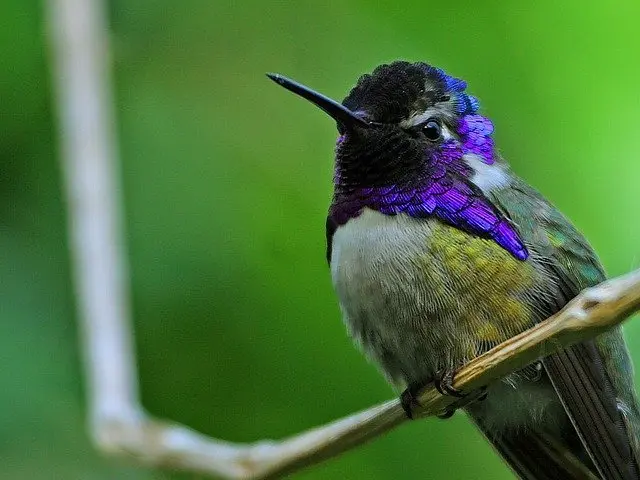
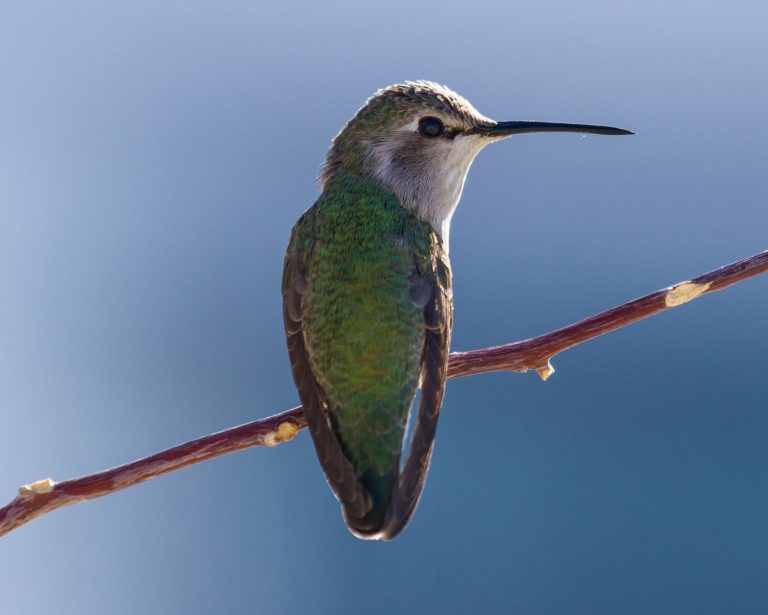
Costa’s Hummingbirds are predominantly desert hummingbirds with striking iridescent purple throat patches that flare out and a purple crown. Their backs are green and their bellies are white with green coloring on the sides. Female Costa’s Hummingbirds lack the purple color and are more white on the belly.
- Length: 3.5 in ( 7.6 – 8.8 cm)
- Weight: 0.1-0.1 oz (2-3 g)
Costa’s Hummingbirds are residents in Baja California and southern California and southwestern Arizona. They also migrate between the Pacific Coast of Mexico in winter and up into Arizona, the southern edges of Nevada and Utah, and California for breeding.
Desert scrub, chaparral, and deciduous forest provide the habitat of Costa’s Hummingbirds and they visit many different species of plants. Nests are built quite low at three to seven feet above the ground in shrubs and they may have up to two broods in a year.
8. Broad-billed Hummingbird
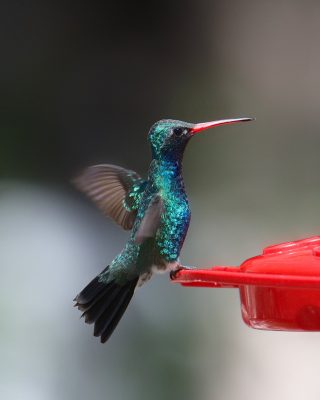
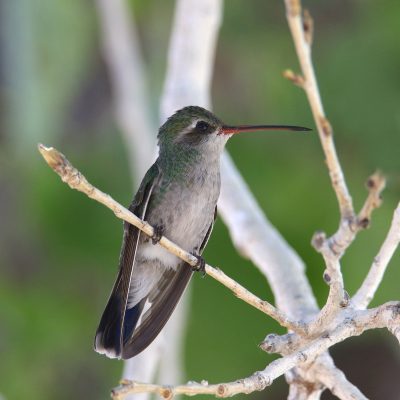
Broad-billed Hummingbirds are brilliantly colored, even among hummingbirds. The males are rich metallic green all over with a blue throat that extends down the breast. Females have a pale belly and both males and females have red beaks that are black-tipped and wide near their heads.
- Length: 3.1 – 3.9 in (8-10 cm)
- Weight: 0.1-0.1 oz (3-4 g)
Broad-billed Hummingbirds are resident all year in central Mexico and the Pacific Coast of Mexico. Some birds migrate north into mountain canyons in southern Arizona and New Mexico, for breeding between March and September and a few remain all year near the Mexican border.
Canyon streams and mountain meadows provide the ideal foraging areas for Broad-billed Hummingbirds but they will also visit backyard feeders. Nests are built quite low to the ground at about 3 feet near streams.
9. Buff-bellied Hummingbird
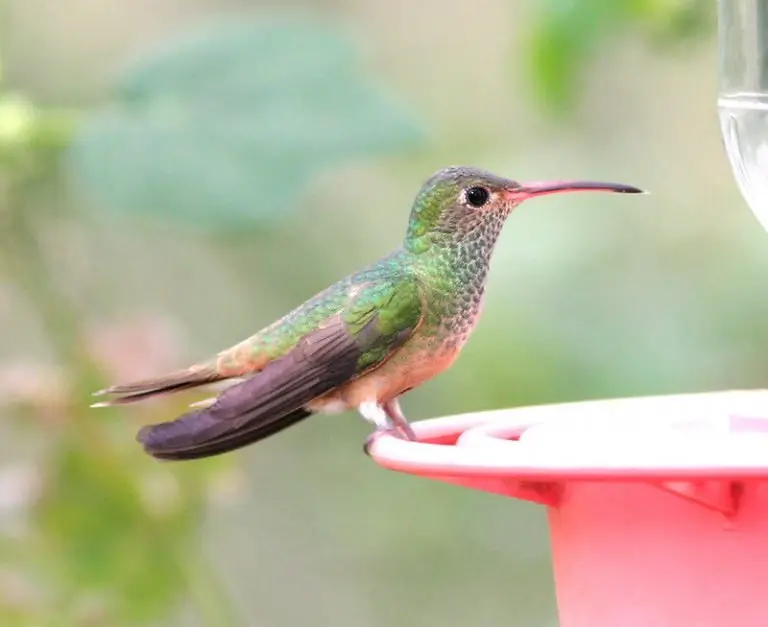
Buff-Bellied Hummingbird (credit: ALAN SCHMIERER)
The Buff-bellied Hummingbird is medium-sized the bill of the male is red with a darker tip but the females are darker.
- Length: 3.9-4.3 in (10-11 cm)
- Weight: 0.1-0.18 oz (2-5 g)
Buff-bellied Hummingbirds breed in southern Texas and the Yucatan peninsula of Mexico, through to Central America. In winter the Buff-bellied Hummingbird will migrate short distances along the Gulf Coast along to Louisiana and Florida.
Nesting occurs from April to August in large shrubs or small trees, quite low to the ground. They lay 2 white eggs and may have 2 broods per year.
Semi-open habitats or woodland edges provide the ideal habitat for Buff-bellied Hummingbirds and they will also visit backyards for flowers or nectar feeders. Small insects also make up some of their diets.
You can attract more Buff-bellied Hummingbirds with nectar feeders and red tubular flowers such as Turk’s cap and red salvia.
10. Calliope Hummingbird

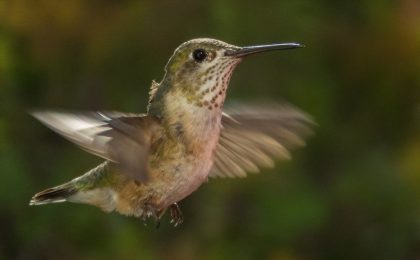
The tiny ping ball-sized Calliope Hummingbird is the smallest bird in the United States but still manages to fly more than 5000 miles each year all the way from Mexico up as far as Canada and back. They also punch above their weight when it comes to defending their territory and even chase Red-tailed Hawks.
Male Calliope Hummingbirds have bright magenta throats, (known as the gorget), glossy green backs and flanks, and a dark tail. Females lack the iridescent throats and are more pinkish-white underneath rather than white in the males.
- Length: 3.1-3.5 in (8-9 cm)3
- Weight: 0.1-0.1 oz (2.3-3.4 g)
- Wingspan: 4.1-4.3 in (10.5-11 cm)
Calliope Hummingbirds’ spring migration is to the Rocky Mountains along the Pacific Coast to breeding areas in California, Colorado, and up to northwestern states, Alberta, British Columbia, and Vancouver Island. They start migration relatively early in February to arrive from Mid-April to early May as far north as Canada.
Fall migration is by the Rocky Mountains to wintering grounds in southwestern Mexico, but also more recently to the Gulf Coast in late August and September.
Nests are usually on evergreen trees and they may reuse them or build on top of an old nest.
11. Rivoli’s Hummingbird
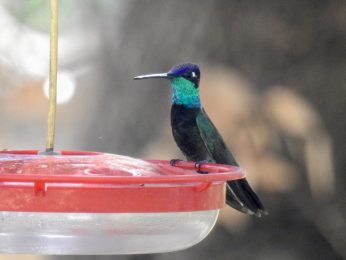
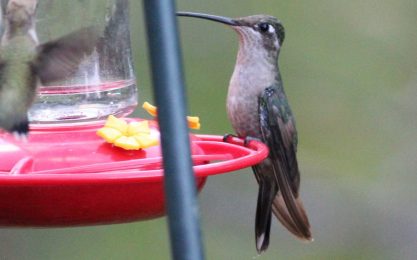
Rivoli’s Hummingbirds are large hummingbirds with more striking coloring than most hummingbirds as they have an iridescent purple crown as well as the more usual iridescent throat in the males, which is emerald green. Males are dark green and the females are green on the back and grayish underneath.
- Length: 4.3-5.5 in (11-14 cm)
- Weight: 0.3-0.3 oz (7-8 g)
Rivoli’s Hummingbirds are resident in Mexico and Central America but some do migrate north into southern Arizona and New Mexico and southwestern Texas. They can be found in pine-oak forests in mountainous regions but will visit feeders in their range. They build nests relatively high up.
12. Violet-crowned Hummingbird
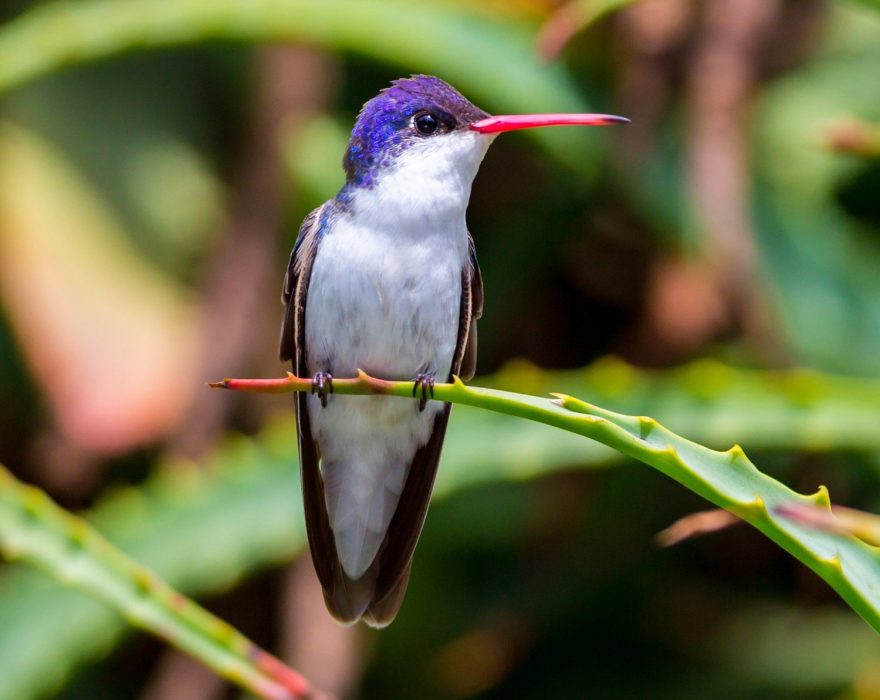
Violet-crowned Hummingbirds are medium-sized and have a violet cap as the name would suggest. They are dark olive-green on the back and white underneath. their beaks are red with a black tip. Females are less colorful than males. They have metallic bluish-green tails and a blue-black band across the tail near the end.
- Length: 4 in (10 cm)
- Weight: 0.18 oz (5 g)
Violet-crowned Hummingbirds range from the mountains in southeastern Arizona and southwestern New Mexico and down southwestern Mexico. They arrive in the United States in February or March and nest in Arizona and New Mexico between April and September. They generally move south for winter but some may remain at backyard feeders through the winter.
Habitat is tropical deciduous forests and semiarid scrub and nests are often in sycamore or oak trees.
13. Lucifer Hummingbird
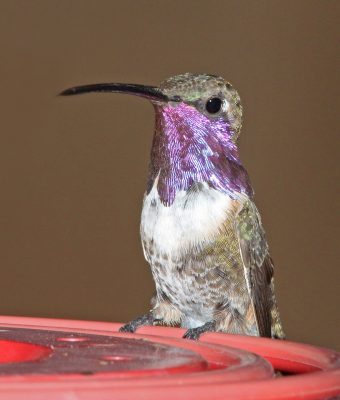
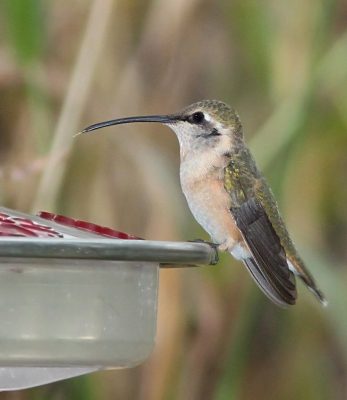
Lucifer Hummingbirds have curved bills, forked tails, a green back, and purple throats in the male.
- Length: 3.9 in (10cm)
- Weight: 0.1-0.1 oz (3-4 g)
These hummingbirds are found in desert habitats and dry canyons and feed on flowering agaves, ocotillo, and century plants. Due to their desert habitat, they are not commonly seen so are quite a sought-after species to spot.
During courtship displays, the males will make sudden dives from 100 feet in front of the females.
Lucifer hummingbirds breed in northern Mexico and small areas of Arizona, New Mexico, and Texas between March and September. They migrate to central Mexico for winter. Nests are usually built on Cacti or succulents and they will have one or two broods a year.
14. Blue-throated Mountain-gem
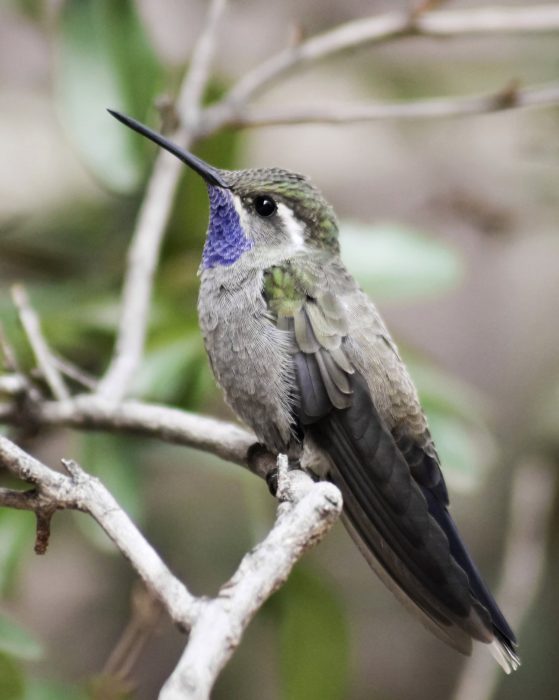
The Blue-throated Mountain-gem is the largest hummingbird that nest in the United States and as the name suggests the males have iridescent blue throats. Both male and female Blue-throated Mountain gems are bronzy-green on the back and grayish below, with white tips on the black tail feathers.
- Length: 4.3-4.7 in (11-12 cm)
- Weight: 0.3-0.3 oz (8.1-8.6 g)
Mostly resident in Mexico but some Blue-throated Mountain gems move north short distances into southeastern Arizona and southwestern Texas. Mountain woodlands along streams with lots of flowers or backyards with feeders are the best places to spot Blue-throated Mountain gems. They feed more in the morning and late afternoon, out of the heat of midday.
Nests of Blue-throated Mountain gems are larger than most to accommodate their larger size and can measure 2 inches wide and 3 – 10 inches high.
15. Mexican Violetear
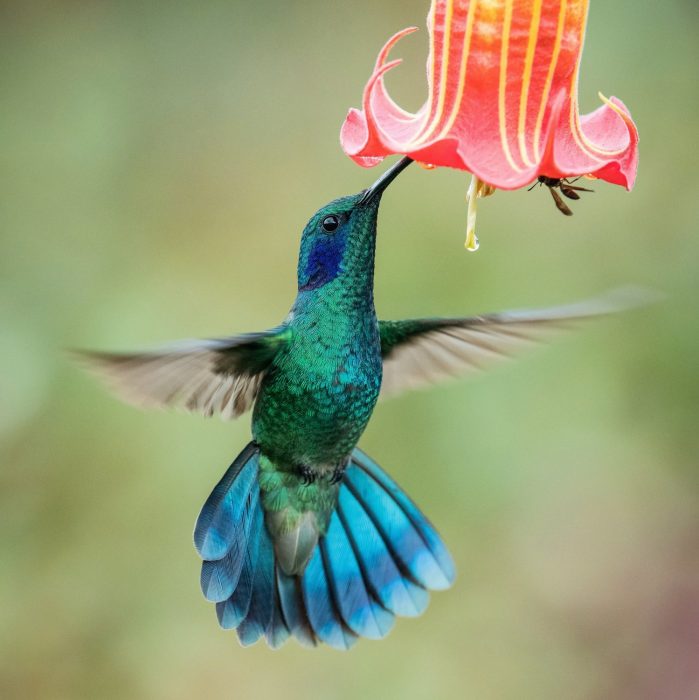
Mexican Violetears are medium-sized hummingbirds that are metallic green with violet patches on the sides of their heads and breasts.
- Length: 3.8 – 4.7 in (9.7 – 12 cm)
- Weight: 0.17 – 0.2 oz (4.8 – 5.6 g)
Mexican Violetears breed in forests in Mexico and through Central America to Nicaragua but can be found as far south as the mountains in Bolivia and Venezuela. Some non-breeding Mexican Violetears may fly north into the United States to central and southern Texas.
16. White-eared Hummingbird
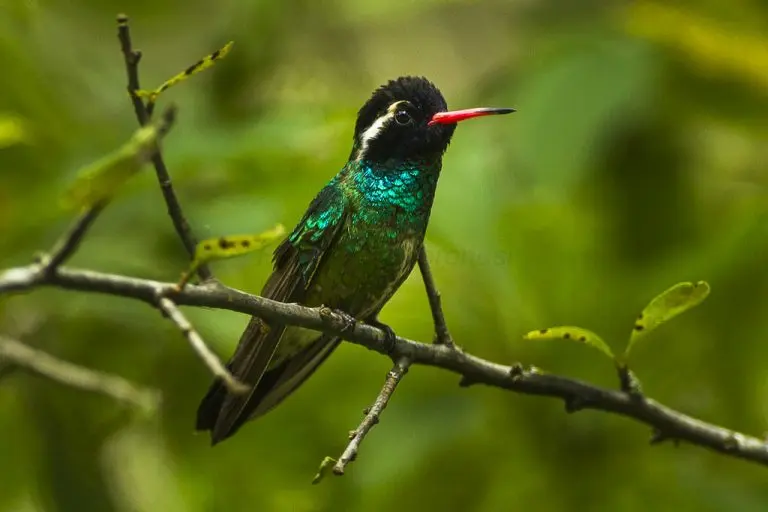
White-eared Hummingbird male (credit: Francesco Veronesi )
White-eared Hummingbirds are green on their backs and breasts with a black head and a white eyestripe on both males and females. Their beaks are red with a black tip. Males have a metallic turquoise green throat with violet patches on the face.
- Length: 3.5 – 4 in (9-10 cm)
- Weight: 0.1 – 0.14 oz (3-4 g)
White-eared Hummingbirds range from Nicaragua up to the mountains in southeastern Arizona, southwestern New Mexico, and western Texas but they are rare in the United States. They usually nest between March to August in northern and central Mexico or later in July in Arizona and they may have 3 broods in a year. They migrate to arrive in the southern United States in March and leave by early September.
Scrubby growth and forests or backyards provide the habitat of White-eared Hummingbirds and they nest in shrubs or low trees.
17. Green-breasted Mango
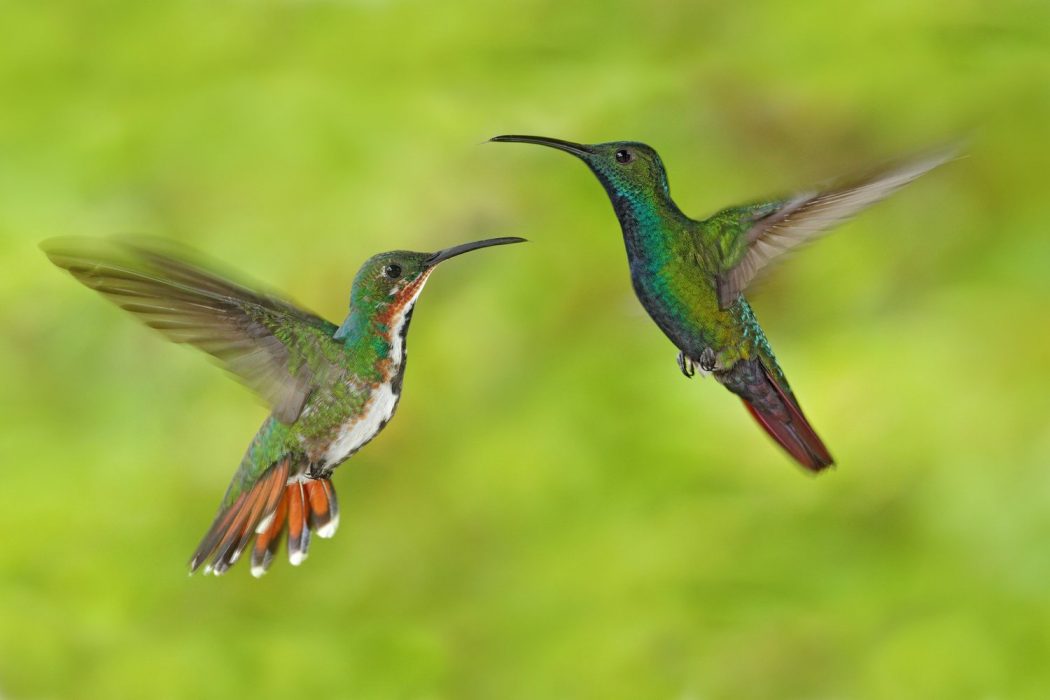
Green-breasted mangoes are glossy bright green on the back and the males have a blackish throat bordered with blue on the chest. Females are white underneath with a black stripe in the middle with a few bluish-green metallic feathers.
- Length: 4.3 – 4.7 in ( 11 – 12 cm)
- Weight: 0.24-0.25 oz (6.8 – 7.2 g)
Green-breasted Mangos are found near the coasts of Mexico and Central America and some down to northern South America. Their habitat is tropical deciduous forests, gardens, and some open or lightly wooded areas.
The Green-breasted Mango is very rare in North America but a few have been sighted in Texas on the southeastern border with Mexico.
18. Berylline Hummingbird
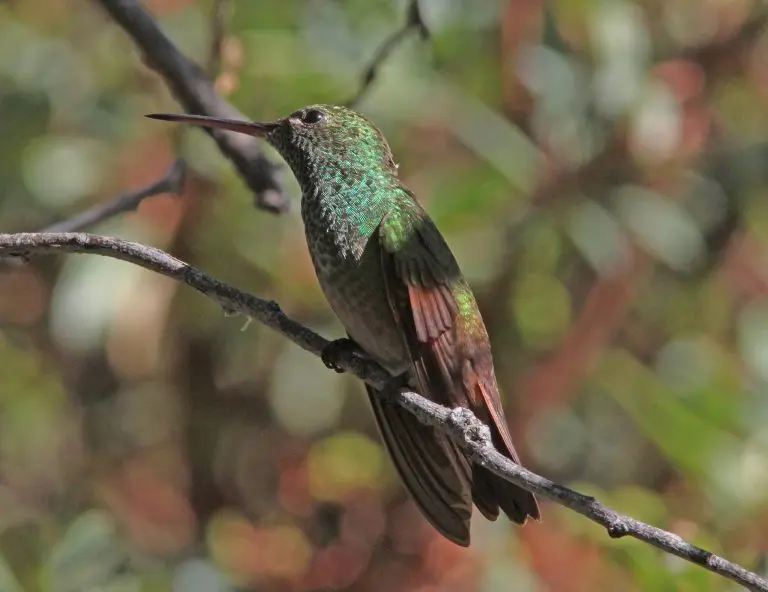
Berylline Hummingbird (credit: ALAN SCHMIERER)
Berylline Hummingbirds are metallic green with a gray lower belly and reddish in the wings. Females are less colorful than males and are slightly smaller. Their upper bills are black and the lower bill is reddish-orange.
- Length: 3 – 4.25 in (8-11 cm)
- Weight: 0.14 – 0.18 oz (4-5 g)
They range from Mexico to Honduras in open woodlands of oak and pine and shady canyons and they will also stray up into southeastern Arizona. They are usually solitary birds and can be aggressive in defending their territory including at hummingbird feeders.
The only place in North America that Berylline Hummingbirds can be found is in southeastern Arizona in the Santa Rita Mountains, Huachuca Mountains, and Chiricahua Mountains during breeding between April and November.
19. Plain-capped Starthroat
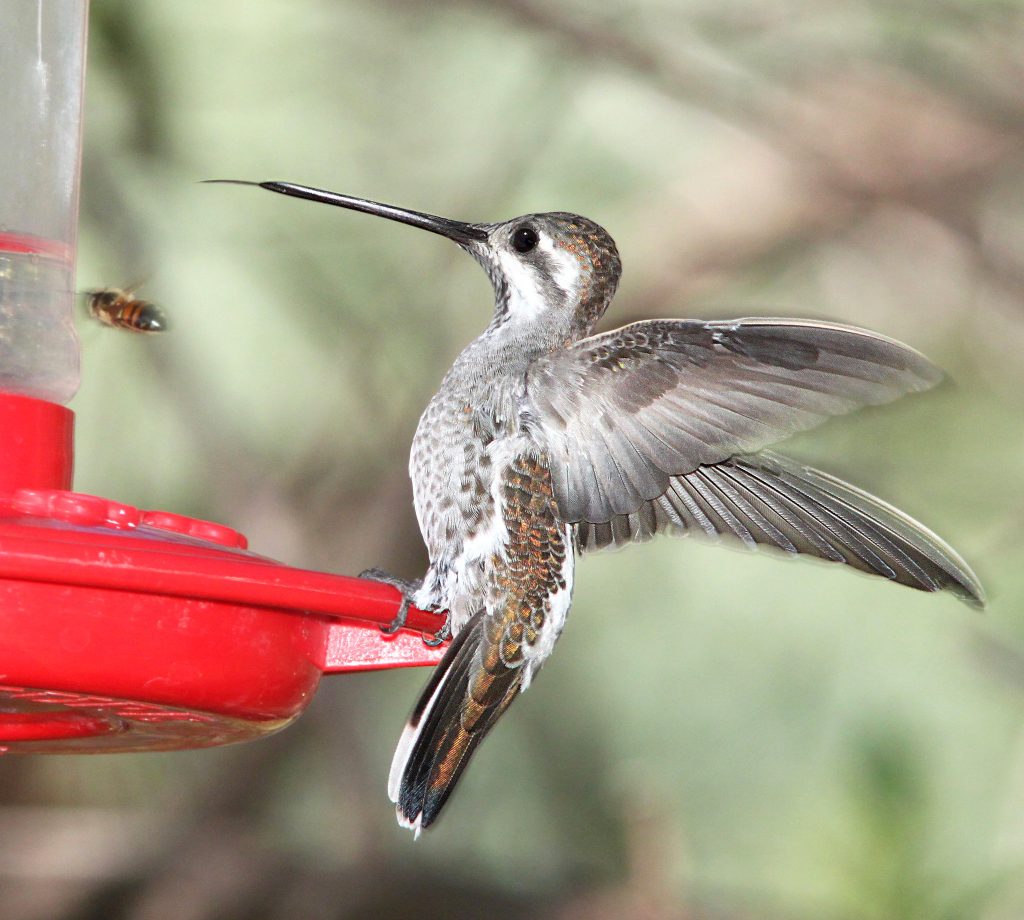
Plain-capped Starthroat (credit: ALAN SCHMIERER)
The Plain-capped Starthroat is large but quite dull in comparison to most hummingbirds with only a small violet-red throat patch that is hard to see as it looks dark in most like. They are also a metallic bronze color rather than the green of most hummingbirds. they have a white patch on the rump and the breast and belly are grayish-white. Females are less colorful than males.
- Length: 4.33 – 4.72 in (11 – 12 cm)
- Weight: 0.24 – 0.28 oz (7 – 8 g)
Arid or semiarid forests and streams along dry forest edges are the usual habitats of Plain-capped Starthroat between Mexico and Costa Rica. Although rare in North America, Plain-capped Starthroat can be seen at the end of the breeding season between June and September in southeastern Arizona at Miller Canyon and the Paton Center for Hummingbirds.
20. Cinnamon Hummingbird
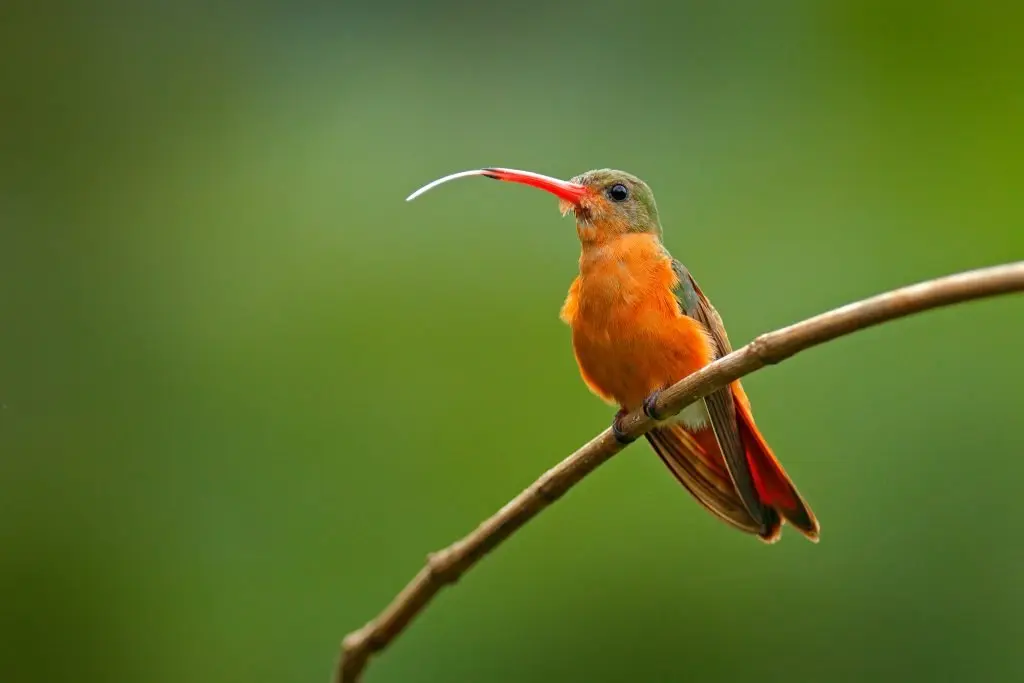
Cinnamon Hummingbirds are bronze-green on their backs and as their name suggests, they are cinnamon-colored underneath from under their chin to their tail. Their tails are reddish and their beaks have a black tip.
- Length: 3.9 in (10 cm)
- Weight: 0.18 oz (5 g)
Usually, Cinnamon Hummingbirds are found from northwestern Mexico down to Costa Rica but a few have ventured into Southwestern United States. They inhabit forest edges of pine and oak and also open scrubby areas, feeding on nectar and insects.
Check out these great articles:
- Live Hummingbird Nest and Feeder Cams
- Common Backyard Birds North America for every state – with Free picture ID printable
- 25 Birds with Red Heads in North America
- 20 Live Feeder Cams from Around the World
Best Nectar Feeders to Attract Hummingbirds in North America
This site is reader-supported and as an Amazon Associate, I earn a commission if you purchase a product I recommend at no extra cost to you.
The more the merrier with Hummingbirds is what I think and they can be territorial so getting a few hummingbird feeders around your backyard is best. We have picked the best hummingbird feeders for you to get hummingbirds buzzing all over your yard.
- Best window mounted hummingbird feeder – Perky-Pet Window Mount Hummingbird Feeder
- Try to count the wingbeats of the next hummingbird to use this feeder!
- Best all-round feeder – First Nature Hummingbird Flower Feeder
- Not only does this feeder feed a lot of hummingbirds at once it is so reasonably priced that you want to get more of them to fill up your yard with the buzz of hummers.
- Best decorative feeder– Grateful Gnome Hummingbird Feeder
- This Hand Blown Glass feeder not only looks great but attracts a lot of hummers.
How to Attract the Hummingbirds of North America to Your Backyard
If you would like to attract more hummingbirds to your yard here are some tips:
- Provide more hummingbird feeders and spread them around your yard to create more territories.
- Ensure you clean and change the hummingbird nectar regularly. You can either buy nectar or make your own, but don’t use any with red dye.
- Provide a water feature such as a birdbath fountain or stream. Ensure that the water is clean and not stagnant
- Grow native plants that will provide food such as salvias, fuschias, trumpet creeper, lupin, columbine, bee balms, and foxgloves
- Don’t use pesticides and herbicides as these may be toxic to birds.
- Provide small perches of thin branches bare of leaves for hummingbirds to rest.
How to Identify Birds in North America
Here are some tips to help you identify birds whether you are out birding or backyard bird watching in North America:
- Size – Size is the easiest thing to notice about a bird. Birds are often measured in inches or centimeters in guide books. It’s best to take a note of the bird in terms of small, medium, or large to be able to look for it later. A small bird is about the size of a sparrow, a medium bird is about the size of a pigeon and a large bird is the size of a goose.
- Shape – Take note of the silhouette of the bird and jot it down or draw the outline. Look at tail length, bill shape, wing shape, and overall body shape.
- Color pattern – Take a note of the main color of the head, back, belly, and wings, and tail for the main color and then any secondary colors or patterns. Also take note of any patterns such as banding, spots, or highlights.
- Behavior – Are they on the ground or high up in the trees. Are they in flocks or on their own? Can you spot what they are eating?
- Habitat – Woodlands, parks, shrubs, grasslands or meadows, shore or marsh.
- Use a bird identification app such as those created by ebird or Audubon

